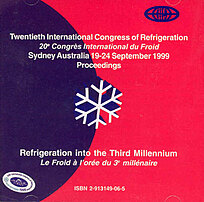
IIR document
Refrigeration system performance using liquid-suction heat exchangers.
Author(s) : KLEIN S. A., REINDL D. T., BROWNELL K. A.
Summary
Heat transfer devices are provided in many refrigeration systems to exchange energy between the cool gaseous refrigerant leaving the evaporator and warm liquid refrigerant exiting the condenser. These liquid-suction or suction-line heat exchangers can, in some cases, yield improved system performance while in other cases they degrade system performance. Although previous researchers have investigated performance of liquid-suction heat exchangers, the study can be distinguished from the previous studies (new correlations, new refrigerants, impact of pressure drop). Reliance on simplified analysis techniques leads to inaccurate conclusions regarding the refrigeration system performance impacts of liquid-suction heat exchangers. From detailed analyses, it can be concluded that liquid-suction heat exchangers that impose minimal low-side pressures are useful for systems using R507A, R134a, R12, R404A, R290, R407, R600, and R410A refrigerants. The liquid-suction heat exchanger is detrimental to system performance in systems using R22, R32, and R717 refrigerants.
Available documents
Format PDF
Available
Public price
20 €
Member price*
Free
* Best rate depending on membership category (see the detailed benefits of individual and corporate memberships).
Details
- Original title: Refrigeration system performance using liquid-suction heat exchangers.
- Record ID : 2000-1256
- Languages: English
- Source: 20th International Congress of Refrigeration: Refrigeration into the Third Millennium.
- Publication date: 1999/09/19
Links
See other articles from the proceedings (447)
See the conference proceedings
Indexing
-
Themes:
CFCs;
HCFCs;
HFCs;
Heat transfer;
Ammonia;
Hydrocarbons;
Blends - Keywords: Refrigerating circuit; R410A; R407; R134a; Calculation; Butane; Liquid-vapour exchanger; Profitability; R507; Ammonia; R404A; R32; R22; R12; Propane
-
On pressure drop in refrigerant tubing. Relatio...
- Author(s) : GRANRYD E.
- Date : 2001/04/01
- Languages : English
- Source: Arab-African Conference for Refrigeration and Air Conditioning.
View record
-
Ausstieg aus R22: Verfügbare Alternativen und d...
- Author(s) : RENZ H.
- Date : 1998/11/18
- Languages : German
- Source: DKV-Tagungsbericht 25. 1998, Würzburg.
View record
-
Effect of refrigerant choice.
- Author(s) : HUNDY G. F., PHAM H. M.
- Date : 2001/11/01
- Languages : English
- Source: Efficient air conditioning: the role of refrigeration. Conference proceedings.
View record
-
Effects of new refrigerants on compressor effic...
- Author(s) : DAVEY J. P.
- Date : 1997/11/20
- Languages : English
- Source: Reducing refrigeration running costs: practical and cost effective solutions.
View record
-
La competencia termodinámica entre refrigerante...
- Author(s) : GARCÍA N. O., VENTURINO E. A.
- Date : 1996/10/02
- Languages : Spanish
- Source: CAF '96. Conferencias presentadas en el Congreso Argentino del Frio.
View record
